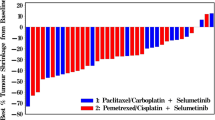Abstract
Optimal scheduling of chemotherapy with molecular-targeted agents is important to maximize clinical benefit. We compared the effects of concurrent and sequential administration of docetaxel and multi-target inhibitor sunitinib malate on tumor cells and xenografts and studied several mechanisms involved in drug interaction to provide experimental data in support of their clinical use in non-small cell lung cancer (NSCLC). Human umbilical vein endothelial cells (HUVECs), NCI-H460 human non-small lung carcinomas cells, and NCI-H460 xenograft were treated with docetaxel and Sunitinib malate, using concurrent and sequential treatment schedules. Cell proliferation was detected by 3-(4,5-dimethylthiazol-2-yl)-5-(3-carboxymethoxyphenyl)-2-(4-sulfophenyl)- 2H-tetrazolium (MTS) assay. Cell cycle analysis was conducted using flow cytometry. Extracellular signal-regulated kinases (ERK1/2) phosphorylation was evaluated by immunoblot analysis. Effects on xenografts were assessed by tumor growth delay. There were no significant difference in the cell proliferation and cell cycle distribution of NCI-H460 cells between concurrent treatment and the first sequential treatment. Both docetaxel and sunitinib malate had no effect on each other in inhibiting ERK1/2 phosphorylation in sequential treatments, while docetaxel eliminated inhibitory activity of sunitinib malate on ERK1/2 phosphorylation in concurrent treatment. For NCI-H460 xenografts, the first sequential treatment showed superior effect to concurrent treatment on inhibiting tumor growth. Combined treatment with sunitinib malate and docetaxel had a greater therapeutic effect than monotherapy, and the first sequential scheduling was more effective than concurrent scheduling, which partly due to the effect of docetaxel on receptor tyrosine kinase (RTK) signaling pathway.





Similar content being viewed by others
References
Jemal A, et al. Cancer statistics, 2003. CA Cancer J Clin. 2003;53:5–26.
Parkin DM, Bray F, Ferlay J, et al. Estimating the world cancer burden: Globocan 2000. Int J Cancer. 2001;94:153–6.
Christensen JG. A preclinical review of sunitinib, a multitargeted receptor tyrosine kinase inhibitor with anti-angiogenic and antitumour activities. Ann Onc. 2007;18:x3–x10.
Montero A, Fossella F, Hortobagyi G, Valero V. Docetaxel for treatment of solid tumours: a systematic review of clinical data. Lancet Oncol. 2005;6(9):229–39.
Sanofi-Aventis. Taxotere (docetaxel) prescribing information. New York: Sanofi-389 aventis; 2007.
Li T, Ling YH, Goldman ID, Perez-Soler R. Schedule-dependent cytotoxic synergism of pemetrexed and erlotinib in human non-small cell lung cancer cells. Clin Cancer Res. 2007;13:3413–22.
Davies AM, et a1. Pharmacodynamic separation of erlotinib and docetaxel (DOC) in advanced non-small cell lung cancer (NSCLC): overcoming hypothesized antagonism. J Clin Oncol. 2007. ASCO annual meeting proceedings part I 2007,25:7618.
Saigal B, Gllsson BS, Johnson FM. Dose-dependent and sequence-dependent cytotoxicity of erlotinib and docetaxel in head and neck squamous cen carcinoma. Anticancer Drugs. 2008;19:465–75.
Mahaffey CM, et al. Schedule-dependent apoptosis in K-ras mutant non-small cell lung cancer cell lines treated with docetaxel and erlotinib: rationale for pharmacodynamic separation. Clin Lung Cancer. 2007;8:548–53.
Christensen J. Antitumor efficacy of sunitinib malate in concurrent and sequential combinations with standard chemotherapeutic agents in non-small cell lung cancer (NSCLC) nonclinical models. AACR Meeting Abstracts. 2008. p. 1433.
Folkman J. Angiogenesis in cancer, vascular, rheumatoid and other disease. Nat Med. 1995;1:27–31.
Sweeney CJ, et al. The antiangiogenic property of docetaxel is synergistic with a recombinant humanized monoclonal antibody against vascular endothelial growth factor or 2-methoxyestradiol but antagonized by endothelial growth factors. Cancer Res. 2001;61:3369–72.
Wan X, Shen N, Mendoza A, Khanna C, Helman LJ. CCI-779 inhibits rhabdomyosarcoma xenograft growth by an antiangiogenic mechanism linked to the targeting of mTOR/Hif-1α/VEGF signaling. Neoplasia. 2006;8:394–401.
Mendel DB, et al. In vivo antitumor activity of SU11248, a novel tyrosine kinase inhibitor targeting vascular endothelial growth factor and plateletderived growth factor receptors: determination of a pharmacokinetic/pharmacodynamic relationship. Clin Cancer Res. 2003;9:327–37.
O’Farrell AM, et al. SU11248 is a novel FLT3 tyrosine kinase inhibitor with potent activity in vitro and in vivo. Blood. 2003;101:3597–605.
Wasylyk C, et al. Inhibition of the Ras-Net (Elk-3) pathway by a novel pyrazole that affects microtubules. Cancer Res. 2008;68:1275–83.
Liebmann C. Regulation of MAP kinase activity by peptide receptor signalling pathway: paradigms of multiplicity. Cell Signal. 2001;13:777–85.
Zhu XF, Liu ZC, Zeng YX. Tyrosine kinase receptor-mediated signal transduction and cancer treatment. Acta Pharm Sin. 2002;37:229–34.
Author information
Authors and Affiliations
Corresponding author
Rights and permissions
About this article
Cite this article
Wang, D., Jiang, Z. & Zhang, L. Concurrent and sequential administration of sunitinib malate and docetaxel in human non-small cell lung cancer cells and xenografts. Med Oncol 29, 600–606 (2012). https://doi.org/10.1007/s12032-011-9905-0
Received:
Accepted:
Published:
Issue Date:
DOI: https://doi.org/10.1007/s12032-011-9905-0




